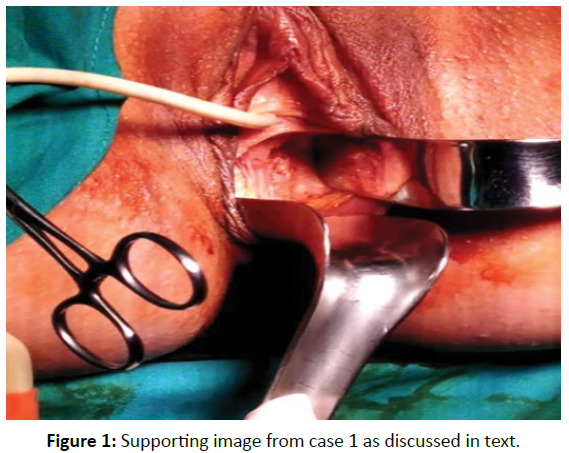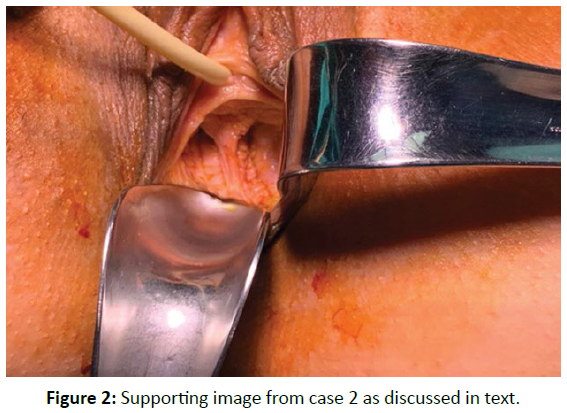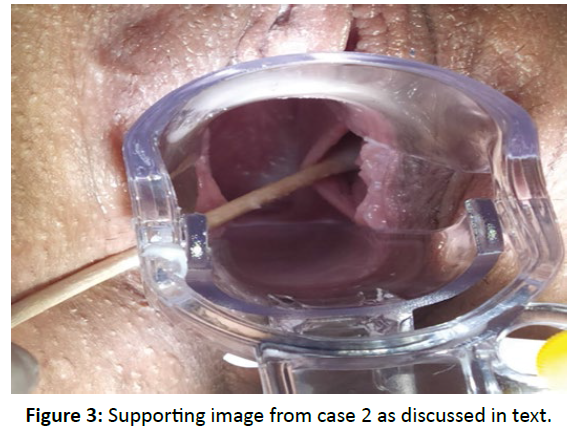Case Series - (2022) Volume 8, Issue 6
Three Cases of Congenital Anomalies U2bC2V1 with different Reproductive Outcomes: Is it Cause of Infertility?
Olga Triantafyllidou1,
Maria Papageorgiou1,
Panagiotis Christopoulos1,
Stavroula Kastora2*,
Emmanouil Kalampokas1,
Theodoros Kalampokas1 and
Nikos Vlahos1
12nd Department of Obstetrics and Gynecology, “Aretaieion” University Hospital, Athens, Greece
2Department of Medicine and Applied Sciences, School of Medicine Polwarth Building, University of Aberdeen, Foresterhill Campus, Aberdeen, UK
*Correspondence:
Stavroula Kastora, Department of Medicine and Applied Sciences, School of Medicine Polwarth Building, University of Aberdeen, Foresterhill Campus, Aberdeen,
UK,
Tel: +447414752664,
Email:
Received: 06-May-2022, Manuscript No. IPGOCR-22-12753;
Editor assigned: 09-May-2022, Pre QC No. IPGOCR-22-12753 (PQ);
Reviewed: 20-May-2022, QC No. IPGOCR-22-12753 (Q);
Revised: 24-May-2022, Manuscript No. IPGOCR-22-12753 (R);
Published:
31-May-2022, DOI: 10.36648/2471-8165.8.6.26
Abstract
Background: Congenital uterine anomalies (CUAs) consist structural disorders of the female genital tract due to
abnormal fusion or resorption of the Müllerian ducts. The prevalence of CUAs is 5.5% in the general population,
8.0% in infertile women and 13.3% in women with a history of miscarriage.
Results: We present three cases of women with complex genital tract anomalies (U2bC2V1), including cervical
duplication and vaginal septum with different reproductive outcomes.
Conclusion: A complete uterine septum with double functional cervix may have a wide spectrum of reproductive
outcomes. We advised nulliparous women to complete their evaluation by performing hysteroscopy. It provides
reliable information for the anatomical status of the cervix, tubal ostia and, especially, uterine cavity. In cases of
infertility or recurrent pregnancy losses, the dilemma is whether to proceed with the resection of the uterine
septum in combination with resection of vaginal one.
Key Messages: A complete uterine septum with double functional cervix may have a wide spectrum of reproductive
outcomes; The association of uterine anomalies with the woman’s fertility status remains controversial; Patients
with septate uterus and history of infertility or poor pregnancy outcome should complete their investigation and
proceed with resection of septum.
Introduction
Congenital Uterine Anomalies (CUAs) comprise of structural
disorders of the female genital tract that arise because of
abnormal fusion or resorption of the Müllerian ducts.
The prevalence of CUAs is estimated to be at 5.5% in the
general population, whilst up to 8.0% in infertile women, 13.3%
in women with a history of miscarriage and 24.5% in those who
were infertile that have suffered a miscarriage [1]. The past few
years a combination of Three-dimensional (3D) ultrasound,
Magnetic Resonance imaging (MRI), laparoscopy and hysteroscopy had contributed significantly to the classification
these anomalies. In contemporary medicine, the majority of
cases can be diagnosed in a less invasive way because of the
increased use of MRI and 3D ultrasound [2].
CUAs are mostly asymptomatic and incidentally diagnosed
during the annual check-up or investigation of recurrent
pregnancy loss or infertility. The reproductive outcomes
in women with such anomalies range widely: from normal
to severe adverse outcomes, including preterm birth or
miscarriage [1,3].
In this work we present three cases of women upon patient
consent with complex genital tract anomalies classified as per
the ESHRE consensus (U2bC2V1), including complete uterine
septum, cervical duplication and vaginal septum respectively,
with different reproductive outcomes [4].
Case Presentation
1st Case
A 51-year-old G2P1 (vaginal delivery) presenting with severe
worsening menorrhagia attributed to multiple leiomyomas, was
referred to our clinic. Pelvic examination revealed an enlarged
uterus, small vertical vaginal septum in the upper third of vagina
and two external cervical orifices. Complete septate uterus and
cervical duplication were found during 2D (Two Dimensional)
Transvaginal Ultrasound (TVUS) and confirmed by MRI. Since
she had already undergone three myomectomies and after
excluding of endometrial pathology by conducting endometrial
biopsy, hysterectomy was recommended. Those findings were
also confirmed intraoperatively. The histopathology report
mentioned the presence of two intracervical canals, 3.5 cm
each, and two external cervical orifices (Figure 1).

Figure 1: Supporting image from case 1 as discussed in text.
2nd Case
A 25-year-old G0P0 woman presenting with dyspareunia
attended our clinic for consultation. The gynecological
examination revealed a longitudinal non-obstructing vaginal
septum with a well-formed cervix in the left and a hypoplastic
one in the right side. During 2D ultrasound complete septate
uterus was revealed and patient was referred for pelvic MRI
to confirm this finding. MRI findings enabled classification of
the identified anomaly as U2bC2V1. The patient underwent
resection of the vaginal septum and diagnostic hysteroscopy
from both cervical orifices. Laparoscopy was performed
simultaneously due to a persistent ovarian simple cyst,
measuring 6 cm in diameter (which was resected) and
confirmed normal contour of uterus (Figure 2).

Figure 2: Supporting image from case 2 as discussed in text.
3rd Case
A 38-year-old G0P0 infertile woman presented to our clinic for
fertility counseling and dyspareunia management. The patient
was evaluated by pelvic examination, TVUS and hormonal blood
test assessment for ovarian reserve markers. Gynecological
examination revealed a vertical vaginal septum on the left side
of vagina with a well-formed cervix in the right side. The left
part of the vagina was too small to examine the left cervix.
TVUS revealed 2 normal cervixes and 2 endometrial cavities
completely separated by septum. The external contour of the
uterus, according to 2D ultrasound and MRI, was found to be
normal. Hysterosalpingography was performed only from the
right side and revealed well-formed right side of the uterine
cavity and patent right fallopian tube. After TVUS and blood
test assessment, the patient was diagnosed with poor ovarian
reserve. The AFC (Antral Follicle Count) was 4 and her AMH
(Anti-Mullerian Hormone) was 0.9 ng/ml. Partners’ sperm count
was found to be within normal range. Therefore, the patient’s
infertility was attributed mostly to poor ovarian reserve and
the possibility of In Vitro Fertilisation (IVF) was discussed. The woman was proceeded with diagnostic hysteroscopy both of
cavities and resection only of the vaginal septum (Figure 3).

Figure 3: Supporting image from case 2 as discussed in text.
Discussion
Septate uterus is believed to evolve due to the failed fusion
or resorption of the Müllerian ducts, during the period of
embryologic development [5]. According to the new ESHRE (European Society of Human Reproduction and Embryology)/
ESGE (European Society for Gynaecological Endoscopy)
classification system of female genital tract congenital
anomalies, septate uterus involves all those cases with a
normal external contour and an internal indentation extending
>50% of the uterine wall thickness [4].
During the last few years, cases of congenital anomalies
combining cervical duplication with a uterus of normal shape
have been reported. The different types of CUAs have been
associated with varying degrees of suboptimal reproductive
outcomes. Women with canalization defects seem to have
the poorest reproductive performance, including reduced
conception rates, which more often than not are linked to
implantation failure [6-9]. The present study describes three
cases of women with duplicated cervices and septate uteruses.
A complete uterine septum with double "normal" cervix may
have a wide spectrum of reproductive outcomes. We advised
nulliparous women to complete their evaluation by performing
hysteroscopy. This provides reliable information of the
anatomical status of the vagina, cervix, uterine cavity and tubal
Ostia. There is no doubt that women with dyspareunia should
undergo resection of vaginal septum. In cases of infertility or
recurrent pregnancy loss, the dilemma remains as to whether
or not to proceed with the resection of the uterine septum in
combination with resection of the vaginal section.
Several studies have evaluated the association between
congenital anomalies and reproductive outcomes with
controversial conclusions since they are associated with both
acceptable as well as adverse outcomes [10]. Canalization
defects, such as septate uterus, seem to be associated with
poor obstetrical outcomes including reduced conception rates,
increased risk of miscarriages and preterm births. A systematic
review of 3805 women with both canalization and unification
defects reported decreased pregnancy rates in the canalization
defect group and significant higher risk for preterm birth,
miscarriage and fetal malpresentation. Additionally, women
with septate uterus appear to have poorer outcomes when
compared with those with subseptate uterus [9]. Naeh A, et
al. [11] compared the course of 167 pregnancies of women
with CUAs to the general population. Overall higher rates of
major adverse outcomes were reported in the CUAs group
but safe conclusions regarding the CUAs subtype could not be
drawn. Although the exact mechanism that causes infertility
in women with septate uterus remains obscure, implantation
alterations seem present the most plausible explanation [12].
Conversely, as infertility is a multifactorial condition, it is hard
to be exclusively attributed to septate uteri [5]. These findings
were confirmed by the first case of 51-year-old woman, who
had no history of infertility and had one normal delivery.
Septate uterus is the most frequent congenital anomaly
accounting for 35% of all uterine anomalies. Despite that,
there is still no consensus regarding the proper management
[13]. The most frequent intervention in these women includes
hysteroscopic septum resection. Various observational studies
report that the restoration of the anatomy of the uterus
improves live birth rates [14-18]. Bendifallah S, et al. [15] have
analyzed pregnancy rates amongst 128 women with primary
infertility or recurrent miscarriage and septate uterus. After metroplasty, via hysteroscopy, 60.9% of women became
pregnant while the birth rate in this group was reported at 53.1%
and the miscarriage rate significantly decreased [15]. However,
the outcome seems to be good even without an intervention.
Rikken JF, et al. [19] reports the lack of evidence to support
the surgical intervention and the need for relevant RCTs. From
nine comparative studies regarding miscarriages and live birth
rates with and without metroplasty, three supported better
outcomes by surgery while six found expectant management
safer and equally effective. Furthermore, the possibility of
intrauterine synechiae after hysteroscopic resection of uterine
septum should also be considered. Recently an internationalmulticenter-
open-label -randomized controlled trial compared
reproductive outcomes in women with septate uterus using
either expectant management either septum resection in 80
patients was published. According to their findings live birth
rates, miscarriages and preterm birth rates were not improved
by the septum resection. More specifically, live birth rate
occurred in 31% of the metroplasty group and 35% of the
expectant group [20].
In our institution, we suggest all patients with complete uterine
septum to perform diagnostic hysteroscopy. We used to adopt
the expectant management in women without history of
infertility if at least one endometrial cavity was found to be
“normal” during diagnostic hysteroscopy. In infertile women,
after excluding all possible causes of infertility (male factor,
poor ovarian reserve etc.), the possibility of resection of uterine
septum should be considered.
Conclusion
Congenital anomalies are not as rare as they may previously
thought to be. The association of these anomalies with the
woman’s fertility status remains controversial issue as their
impact may vary from asymptomatic presentation to severe
reproductive adverse outcomes. Symptomatology spectra and
literature controversies makes the appropriate management
of these patients challenging. The available research remains
limited and consequently insufficient to allow for any safe
conclusions to be drawn. However, here we suggest that
patients with septate uterus and history of infertility or poor
pregnancy outcome to complete their investigation and
proceed with resection of septum.
REFERENCES
- Chan YY, Jayaprakasan K, Zamora J, Thornton JG, Raine-Fenning N, et al. (2011) The prevalence of congenital uterine anomalies in unselected and high-risk populations: a systematic review. Hum Reprod 17(6):761-171.
[Google Scholar], [Crossref], [Indexed at]
- Akhtar MA, Saravelos SH, Li TC, Jayaprakasan K, Royal College of Obstetricians and Gynaecologists (2019) Reproductive implications and management of congenital uterine anomalies. Int J Gynaecol Obstet 127(5):e1-e3.
[Google Scholar], [Crossref], [Indexed at]
- Jayaprakasan K, Chan YY, Sur S, Deb S, Clewes JS, et al. (2011) Prevalence of uterine anomalies and their impact on early pregnancy in women conceiving after assisted reproduction treatment. Ultrasound Obstet Gynecol 37(6):727-732.
[Google Scholar], [Crossref], [Indexed at]
- Grimbizis GF, Gordts S, Di Spiezio Sardo A, Brucker S, De Angelis C, et al. (2013) The ESHRE/ESGE consensus on the classification of female genital tract congenital anomalies. Human Reprod 28(8):2032-2044.
[Google Scholar], [Crossref], [Indexed at]
- Pfeifer S, Butts S, Dumesic D, Gracia C, Vernon M, et al. (2016) Uterine septum: a guideline. Fertil Steril 106(3):530-540.
[Google Scholar], [Crossref]
- Morales-Roselló J, Peralta LLorens N (2011) Bicervical normal uterus with normal vagina and anteroposterior disposition of the double cervix. Case Rep Med 2011:303828.
[Google Scholar], [Crossref], [Indexed at]
- Antunes IL, Tomás C, Bravo Í, Metello JL, Quintas A, et al. (2019) Double cervix with normal uterus and vagina-an unclassified müllerian anomaly. Int J Fertil Steril 13(1):83.
[Google Scholar], [Crossref], [Indexed at]
- Acién P, Acién M, Sánchez-Ferrer ML (2009) Müllerian anomalies “without a classification”: From the didelphys-unicollis uterus to the bicervical uterus with or without septate vagina. Fertil Steril 91(6):2369-2375.
[Google Scholar], [Crossref], [Indexed at]
- Chan YY, Jayaprakasan K, Tan A, Thornton JG, Coomarasamy A, et al. (2011) Reproductive outcomes in women with congenital uterine anomalies: a systematic review. Ultrasound Obstetr Gynecol 38(4):371-382.
[Google Scholar], [Crossref], [Indexed at]
- Rackow BW, Arici A (2007) Reproductive performance of women with müllerian anomalies. Curr Opin Obstet Gynecol 19(3):229-237.
[Google Scholar], [Crossref], [Indexed at]
- Naeh A, Sigal E, Barda S, Hallak M, Gabbay-Benziv R (2021) The association between congenital uterine anomalies and perinatal outcomes–does type of defect matters?. J Matern Fetal Neonatal Med 8:1-6.
[Google Scholar], [Crossref], [Indexed at]
- Carugno J, Alonso L (2020) Fertility and pregnancy outcomes following hysteroscopic metroplasty of uterine septa. Minerva Obstet Gynecol 74(1):24-30.
[Google Scholar], [Crossref], [Indexed at]
- Corroenne R, Legendre G, May-Panloup P, El Hachem H, Dreux C, et al. (2018) Surgical treatment of septate uterus in cases of primary infertility and before assisted reproductive technologies. J Gynecol Obstet Hum Reprod 47(9):413-418.
[Google Scholar], [Crossref], [Indexed at]
- Grimbizis G, Camus M, Clasen K, Tournaye H, De Munck L, et al. (1998) Hysteroscopic septum resection in patients with recurrent abortions or infertility. Human Reprod 13(5):1188-1193.
[Google Scholar], [Crossref], [Indexed at]
- Bendifallah S, Faivre E, Legendre G, Deffieux X, Fernandez H (2013) Metroplasty for AFS Class V and VI septate uterus in patients with infertility or miscarriage: reproductive outcomes study. J Minim Invasive Gynecol 20(2):178-184.
[Google Scholar], [Crossref], [Indexed at]
- Roy KK, Singla S, Baruah J, Kumar S, Sharma JB, et al. (2011) Reproductive outcome following hysteroscopic septal resection in patients with infertility and recurrent abortions. Arch Gynecol Obstet 283(2):273-279.
[Google Scholar], [Crossref], [Indexed at]
- Tonguc EA, Var T, Batioglu S (2011) Hysteroscopic metroplasty in patients with a uterine septum and otherwise unexplained infertility. Int J Gynaecol Obstet 113(2):128-130.
[Google Scholar], [Crossref], [Indexed at]
- Mollo A, De Franciscis P, Colacurci N, Cobellis L, Perino A, et al. (2009) Hysteroscopic resection of the septum improves the pregnancy rate of women with unexplained infertility: A prospective controlled trial. Fertil Steril 91(6):2628-2631.
[Google Scholar], [Crossref], [Indexed at]
- Rikken JF, Kowalik CR, Emanuel MH, Mol BW, Van der Veen F, et al. (2017) Septum resection for women of reproductive age with a septate uterus. Cochrane Database Syst Rev 1(1):CD008576.
[Google Scholar], [Crossref], [Indexed at]
- Rikken JF, Kowalik CR, Emanuel MH, Bongers MY, Spinder T, et al. (2021) Septum resection versus expectant management in women with a septate uterus: An international multicentre open-label randomized controlled trial. Human Reprod 36(5):1260-1267.
[Google Scholar], [Crossref], [Indexed at]
Citation: Triantafyllidou O, Papageorgiou M, Christopoulos P, Kastora S, Kalampokas E, et al. (2022) Three Cases of Congenital Anomalies U2bC2V1 with different Reproductive Outcomes: Is it Cause of Infertility? Gynecol Obstet Case Rep. Vol.8 No.6:26.
Copyright: © Triantafyllidou O, et al. This is an open-access article distributed under the terms of the Creative Commons Attribution License, which permits unrestricted use, distribution, and reproduction in any medium, provided the original author and source are credited.




